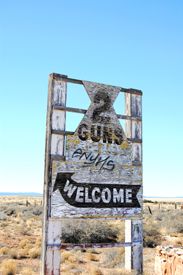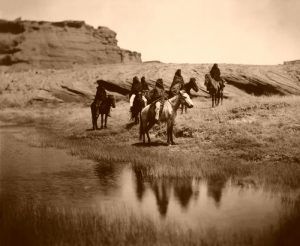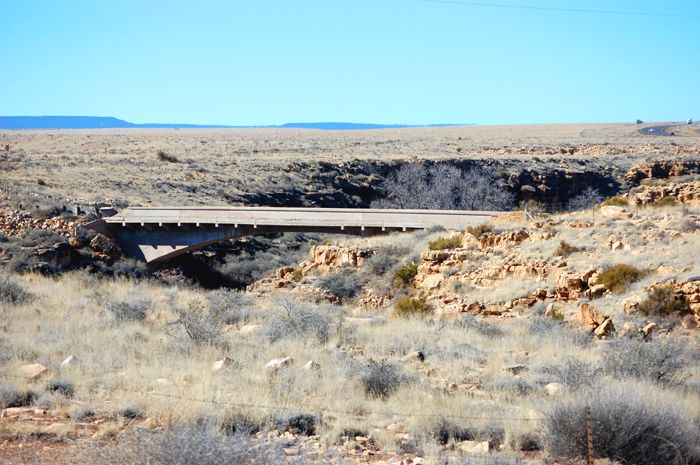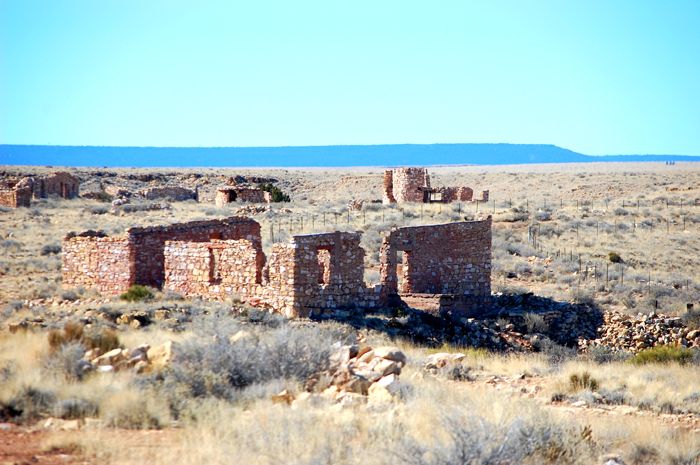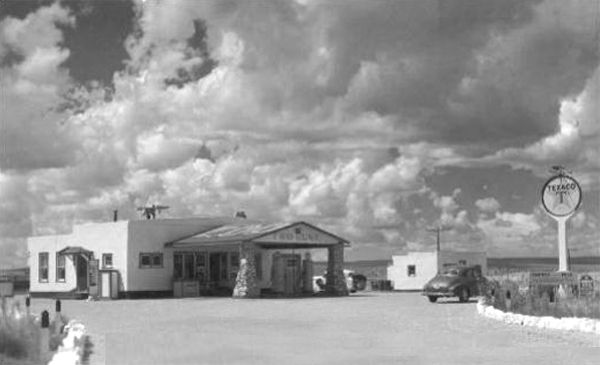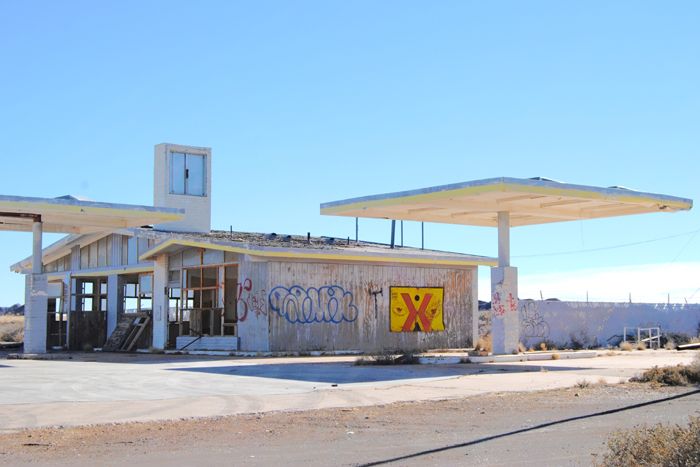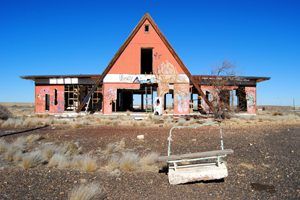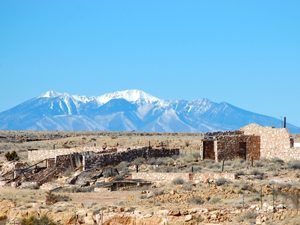Two Guns, Arizona, is a Route 66 ghost town in Coconino County, about 30 miles east of Flagstaff. Located on the east rim of Canyon Diablo, it prospered as a tourist stop along Route 66 for many years before it was bypassed by Interstate 40.
Long before the settlement of Two Guns began, this area had long been inhabited by Native Americans, as evidenced by artifacts found at the site that date back to between 1050 and 1600 A.D.
The first American settlers to arrive in the area were traders and mountain men who established a trading post called the Canyon Lodge. The traders had a good relationship with the Navajo; however, things changed when the U.S. Cavalry began to round up the members of the Navajo tribe in 1864 to place them on a reservation at Fort Sumner, New Mexico. After being imprisoned for four years, they were released to return to their homeland in Arizona in 1868. Many of them returned to Canyon Diablo
The area was the site of a major confrontation between the bitter enemies of the Navajo and the Apache. For years, battles between the two tribes had been continual. In 1878, a group of Apache warriors attacked a Navajo camp and murdered everyone except three Navajo girls who were taken as prisoners. Afterward, they raided and looted the area. In response, Navajo warriors from another camp sent their men after the Apache. They finally found them hidden in a cave, and the Navajo lit sagebrush fires at the cave’s exit and shot any warrior who tried to escape. In the end, 42 Apache men died and were stripped of their valuables. The murder site is referred to as the “Death Cave.”
During the winter of 1879-80, Billy the Kid and his outlaw gang hid in the ruins of a stone house and corral on the west rim of Canyon Diablo, across from Two Guns.
When white settlers began to populate the area, they recognized it was an ideal place to cross Canyon Diablo – first by wagon, then later by motor cars. In 1880, about three miles north of the present-day site of Two Guns, a railroad town called Canyon Diablo was established, which would become a ghost town before Two Guns was even born.
By 1912, various homesteaders were staking claims in the area when the National Old Trails Road was established. Two years later, a potential bridge across Canyon Diablo was surveyed and three years later a concrete bridge, with reinforcing steel was built and the road was opened to traffic.
In 1914, Mr. and Mrs. Daniel B. Oldfield settled by the side of the new road and built a square stone house that they operated as a trading post for travelers, prospectors, cowboys, sheepherders, and Indians. This site later grew into a gas station and eatery known as the Canyon Lodge.
In the 1920s, Earle and Louise Cundiff purchased about 320 acres of land and constructed a large stone building on the west side of the canyon, which also served as a trading post. By 1922, the Cundiffs also established a restaurant and gasoline pumps.
In 1925, Henry “Two Gun” Miller, who claimed to be a full-blooded Apache, leased some land from the Cundiffs. A reported eccentric hermit who lived in the area was said to be wild, violent, and hostile to visitors. He advertised himself as “Chief Crazy Thunder” and wore his long hair braided. He and his wife, with the help of Hopi Indians in the area, began to build pens for a zoo to house mountain lions and other desert animals. They also built a long stone structure that served as an entrance into the zoo and contained a small store and living quarters. Miller sold the skeletal remains of the Apache who had been killed years earlier to tourists. Afterward, the town became known as “Two Guns.”
The following year, the National Old Trails Road became a part of Route 66, but Miller wouldn’t be around long to appreciate the profits of the increased traffic. On March 3, 1926, Miller got into a dispute with Earle Cundiff over his lease and then shot and killed Cundiff. Amazingly, even though Cundiff was unarmed, Miller was acquitted of murder. Afterward, he returned to Two Guns and was mauled by two mountain lions, bitten by a poisonous Gila dragon, and became ill. He left Two Guns with considerable silver, turquoise jewelry, and merchandise.
In the fall of 1929, the Miller’s store was burned, and Mrs. Cundiff put in a large frame building from which she continued to conduct a trading post and tourist stop. However, Miller soon returned and said the land was rightly his, which resulted in a series of court actions that cost her $15,000 before she finally cleared the title. In 1934, Mrs. Cundiff opened a Texaco service station along a new alignment of Route 66.
Afterward, additional small buildings were also constructed, in which a restaurant and an Indian curio shop were established and operated by others, including Hopi Chief Joe Secakuku. Hopi Indians hired off the reservation and built a pueblo-type house on the side canyon rim directly over the cave. At this time, for a nominal charge, tours were conducted through the Hopi house, where Indian products and other items were sold.
Two Guns became one of many tourist stops along Route 66 with a gas station, overnight accommodations, a cafe, and a souvenir shop. Later, the “zoo” was reopened, including mountain lions, panthers, and bobcats. Their “cages” were huge kiln-like brick, mortar, and chicken wire structures built along the rim and north wall of the canyon.
After I-40 bypassed Two Guns, it, like so many other popular Route 66 stops, died a quick death. Although numerous resuscitations have been attempted, Two Guns still sits lonely and abandoned today.
The site includes the remains of the old bridge that crossed Canyon Diablo when it was part of the National Trail and Route 66. The ruins of the old zoo and several abandoned buildings can also be seen.
Two Guns is just off of I-40 at exit 230 between Flagstaff and Meteor City. After exiting, turn left and cross I-40 south towards the site.
Also See:
Arizona Route 66 Photo Gallery
Canyon Diablo – Meaner Than Tombstone
Sources:
Hinkley, Jim, Route 66 Encyclopedia, Voyageur Press, 2012
Wallis, Michael; Route 66 – The Mother Road; 2001; St Martin’s Press, New York, NY.
Wikipedia – Two Guns
Wikipedia – Historic Properties
Two Guns Trading Post

